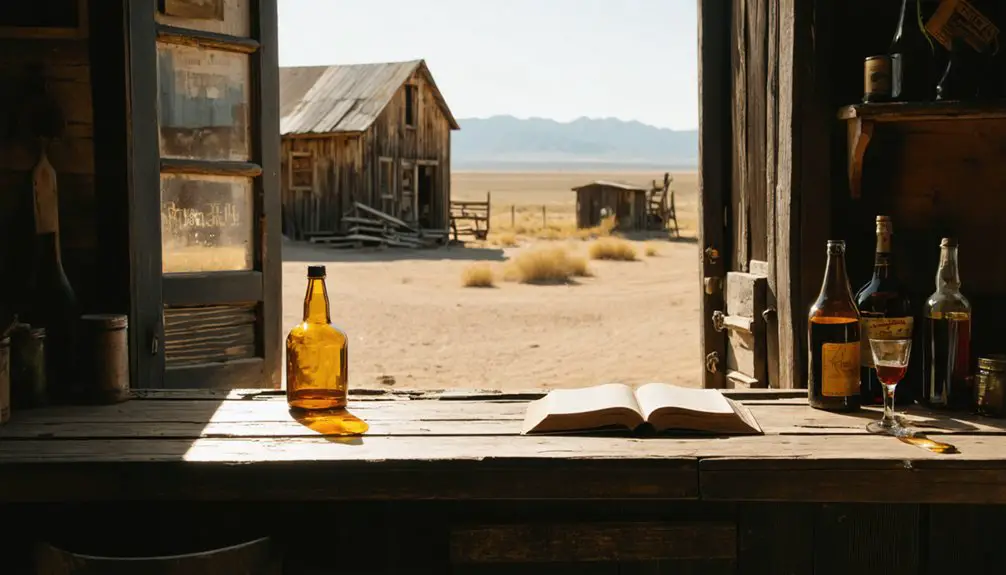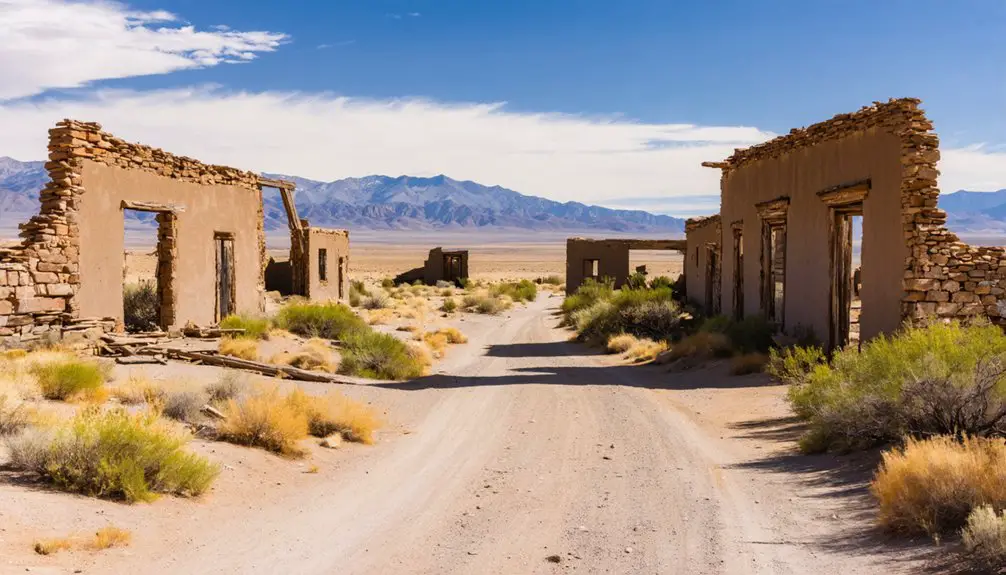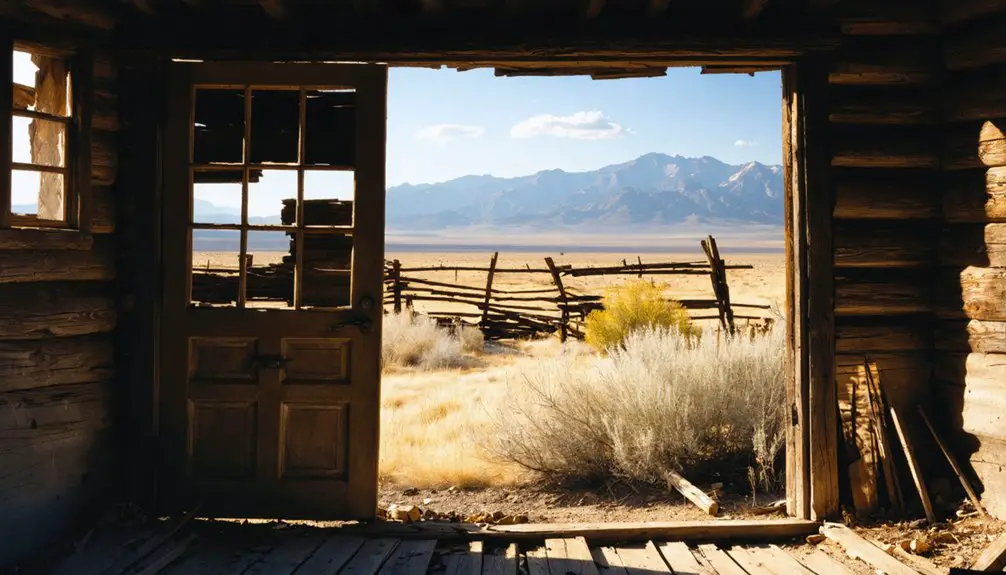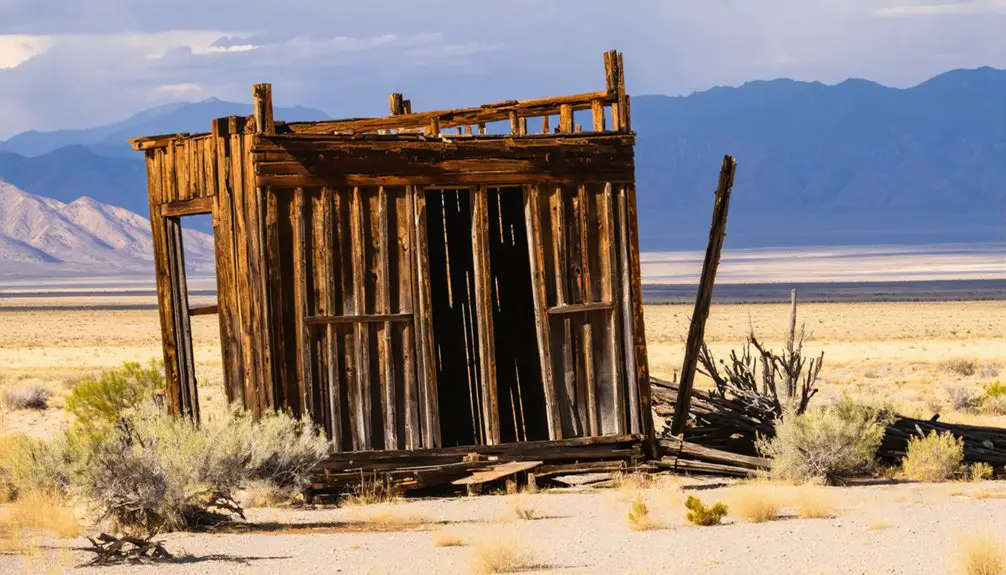You’ll find Golden Arrow, Nevada, a ghost town born from a 1905 gold discovery that sparked a brief but intense mining boom. The settlement quickly grew to support 200 residents with six saloons, a hotel, and a general store by 1907. While most structures have vanished, you can still explore scattered foundations and mining remnants across the desert landscape. The site’s rich silver and gold deposits hold untold stories of frontier ambition and survival.
Key Takeaways
- Golden Arrow was established in 1905 following gold discoveries, quickly growing to support 200 residents with six saloons and essential services.
- The town focused on mining gold and silver from quartz veins, with modern estimates suggesting significant untapped precious metal deposits.
- Social life centered around six saloons where miners gathered for entertainment, gambling, and news exchange from 1905 to 1907.
- Economic decline began by 1909 due to mining competition and outdated extraction methods, leading to rapid population dispersal.
- Today, only scattered foundations and mining equipment remain, with harsh desert conditions requiring high-clearance vehicles for site access.
The Birth of a Mining Frontier
The discovery of gold near Golden Arrow in 1905 ignited a brief but intense mining boom that transformed Nevada’s rugged landscape into a bustling frontier settlement.
Within a year, the Golden Arrow Mining Company established operations, and you’d have witnessed a flurry of mining techniques as prospectors and companies staked their claims across the promising terrain. Like many mining ventures during the Tonopah-Goldfield period, Golden Arrow emerged as part of Nevada’s second major mining boom.
The geological exploration focused on the area’s rich quartz veins, where miners discovered silver minerals alongside native gold deposits. The promising yields attracted multiple companies, leading to a rapid town growth that supported numerous mining operations.
By 1907, you’d have found yourself in a thriving boomtown complete with six saloons, a hotel, and a store.
The settlement’s rapid growth reflected the era’s pioneering spirit, though prospectors initially struggled to recognize that the valuable gold lay hidden in soft, disintegrated rock rather than traditional hard quartz deposits.
Life in Early Golden Arrow
You’d have found Golden Arrow’s daily life centered around mining operations, with workers shuttling between job sites and the town’s six saloons that served as social hubs.
The town’s 200 residents relied on a general store for basic provisions while living in mainly wooden structures built to withstand the harsh desert environment. The discovery of gold ore in 1905 sparked the town’s establishment and brief but vibrant existence. Much like Pine Grove’s stamp mill, the mining infrastructure dominated the landscape.
Despite the challenging conditions and remote location, you’d have witnessed a bustling community sustained by mining activities and the essential services provided by the hotel and local businesses.
Daily Mining Town Life
Life in Golden Arrow centered around its mining operations, where a population of roughly 200 residents carved out an existence in the harsh desert environment during the town’s brief peak around 1907.
You’d find community interactions focused primarily in the town’s six saloons, hotel, and general store, where miners would gather after long days of dangerous underground work. Similar to the historic Pioneer Saloon in Goodsprings, these establishments became the heart of social life.
Daily struggles included coping with isolation and limited supplies, as the town relied on dirt roads for deliveries and basic necessities. The Golden Arrow Mining Company laid out the official townsite in 1906, establishing the basic infrastructure.
Without a completed railroad, you’d face challenging logistics for both equipment and resources.
The frontier conditions meant you’d spend most of your time either working the mines or seeking entertainment in the town’s few establishments, where the social fabric of this rugged mining community was woven together.
Saloons and Social Activities
Social interactions in Golden Arrow revolved around its six vibrant saloons, which served as more than mere drinking establishments during the town’s peak years of 1905-1907.
You’d find these saloons bustling with miners exchanging news, engaging in card games, and participating in impromptu musical performances. The saloon culture fostered essential social bonding through gambling and storytelling, while nearby hotels and stores complemented these gathering spaces. Much like in Goldfield, these establishments attracted fortune seekers and opportunists. Similar to the historic Pioneer Saloon built in 1913, these venues preserved the authentic atmosphere of the Old West.
The male-dominated demographics shaped these establishments into distinctly masculine environments, though women occasionally worked as entertainers or servers.
You’ll notice how the venues created a complex social hierarchy between miners, business owners, and visitors. While the town’s glory days were brief, lasting only until 1908, these saloons represented the heart of Golden Arrow’s community life, where business deals were struck and friendships were forged.
Housing and Basic Necessities
Three distinct types of dwellings dominated Golden Arrow’s architectural landscape during its brief 1905-1907 peak: hastily constructed wooden board-and-batten cabins, simple frame buildings, and a few more permanent structures with stone and concrete foundations.
You’d find these housing materials reflected the town’s rushed development to accommodate nearly 200 residents during the gold rush.
Like many settlements in Mineral County, the town faced harsh living conditions and limited resources.
Daily life centered around basic survival needs.
You’d have hauled water from nearby springs for drinking and washing, while relying on pit latrines for sanitation methods.
Inside your cabin, you’d have used wood-burning stoves for heat and cooking, oil lamps for light, and minimal furniture.
Without electricity or running water, you’d have depended on the general store for preserved foods and essential supplies, making frequent trips to stock up on necessities, similar to the historic general store that still stands in Rhyolite today.
Mining Operations and Technology
Mining operations at Golden Arrow commenced in 1906 when the Golden Arrow Mining Company began extracting gold and silver from quartz-filled fissures in rhyolite near the Page fault zone.
The mining techniques initially focused on underground shaft work, following fault structures that dipped 60° southeast. You’ll find evidence of technological advancements throughout the site’s history, from early shaft sinking to modern heap leach operations in the 1980s.
The operation’s scale remained relatively modest, with drilling and exploration continuing intermittently through the decades.
Modern exploration has utilized reverse circulation drilling, rotary air-track systems, and sophisticated geochemical sampling methods. These techniques have helped identify substantial resources, estimated between 290,000 to 477,000 ounces of gold and 4.1 to 6.2 million ounces of silver across various zones.
The Town’s Brief Glory Days

Following the 1905 gold discovery, you’ll find Golden Arrow quickly became a bustling settlement that attracted hundreds of fortune seekers and reached a peak population of around 200 residents by 1907.
The town’s prosperity manifested in its commercial district, which boasted six saloons, a hotel, and a general store to serve the growing community.
During these glory days, the town hummed with mining activity as several companies staked their claims and established operations, creating an atmosphere of optimistic expansion that would prove all too brief.
Peak Population and Commerce
During its brief heyday around 1880, Golden Arrow swelled to between 7,000 and 10,000 residents as gold-bearing ore deposits attracted waves of fortune seekers.
Population trends closely mirrored the town’s mining success, with roughly 100 houses and numerous tents dotting the landscape at its peak.
You’d have found a bustling commercial district where saloons, dance halls, and boarding houses catered to miners and settlers alike.
The post office, known as Helena, connected Golden Arrow to essential supply networks, while local stores stocked everything from mining equipment to daily necessities.
However, this prosperity proved short-lived. As ore veins depleted, commercial decline set in rapidly.
Businesses shuttered and residents departed, leaving behind empty structures that stand today as silent witnesses to Golden Arrow’s fleeting moment of glory.
Mining Riches Draw Settlers
When word of gold’s discovery spread in 1905 near Nevada’s Kawich Range, prospectors and fortune seekers quickly descended upon what would become Golden Arrow.
Settler motivations centered on the timeless allure of striking it rich, as initial findings of gold and silver sparked mining myths about the area’s potential wealth.
You’d have found a bustling frontier scene by 1907, with six saloons, a hotel, and stores serving the influx of miners and entrepreneurs.
The newly-formed Golden Arrow Mining Company led development, while numerous individual claims dotted the landscape.
The ore deposits, characterized by quartz-filled fissures containing traces of free gold and silver chloride minerals, drew experienced prospectors who could recognize the telltale signs of valuable minerals.
Despite the initial rush, these dreams of wealth would prove short-lived.
Town Life in 1907
Life in Golden Arrow reached its zenith in 1907, as six bustling saloons, a hotel, and a general store served the town’s 200 residents.
You’d have found the saloons acting as makeshift community gathering spots, where miners shared tales of their latest claims and dreams of striking it rich. The transient lifestyle defined the town’s character, with workers coming and going as mining prospects shifted.
While you explored the streets, you’d have witnessed the promising signs of growth – new building foundations being laid and mining equipment arriving regularly.
A surveyed railroad line suggested Golden Arrow’s potential for expansion. The general store stocked essential supplies, while the hotel provided refuge for incoming prospectors seeking their fortune in this dusty corner of Nevada’s mining frontier.
Geographic Location and Access

The remote ghost town of Golden Arrow rests approximately 2.7 miles south of Beatty, Nevada, tucked away near the boundary of the Nevada Test Site.
You’ll find it at coordinates 37°59.6177′ N, 116°36.270′ W, situated in Nye County’s historic Kawich Range mining district.
Despite its remote accessibility, you can reach Golden Arrow by taking U.S. Route 95 and heading southwest from Beatty.
You’ll need a high-clearance vehicle to navigate the rugged terrain, as the site’s mining heritage lies amid rocky outcrops and desert scrub.
While there’s no infrastructure or amenities, you’ll surprisingly find 4G cellular coverage.
The ghost town’s proximity to the Nevada Test Site likely enhances this connectivity.
Remember to bring sufficient supplies and water, as you’re venturing into an entirely off-grid location.
The Decline and Abandonment
Despite initial excitement over gold discoveries in 1905, Golden Arrow’s prosperity proved short-lived as mining operations struggled with insufficient ore profitability from the outset.
Within three years of the town’s establishment, mining competition from better-connected areas and outdated extraction methods accelerated its economic decline.
You’ll find that Golden Arrow’s isolation proved fatal to its survival. Without railroad access and faced with high operational costs, the mines couldn’t compete with more technologically advanced operations elsewhere.
By 1909, the town’s population of 200 had largely dispersed to more promising mining districts. While sporadic attempts to revive mining continued into the 1980s, they all failed.
A 1970s leaching operation destroyed most remaining structures, leaving only scattered ruins, mining shafts, and stone walls as evidence to the town’s brief existence.
Modern-Day Remnants

Modern visitors to Golden Arrow’s remote location encounter little more than scattered foundations and mining remnants, stark evidence of the town’s swift decline.
You’ll find the site’s modern artifacts spread across the high desert landscape, including deteriorating concrete pads, rusted machinery parts, and sealed mine shafts. The remains of what were once bustling establishments – hotels, saloons, and stores – are now reduced to rubble piles, barely distinguishable from one another.
To reach these mining relics, you’ll need a high-clearance vehicle to navigate the dirt roads off Highways 375 and 6.
While the site’s remoteness has helped preserve many artifacts from vandalism, the harsh desert environment continues its slow work of reclamation, leaving only traces of Golden Arrow’s brief but vibrant history.
Historical Significance in Nevada Mining
While many Nevada mining towns experienced brief moments of prosperity, Golden Arrow’s 1905 gold discovery exemplifies the state’s volatile boom-and-bust mining cycle.
In just four years, you’ll find the town transformed from a bustling hub of mining innovations to near abandonment, highlighting the precarious nature of frontier economies.
Golden Arrow’s geological characteristics proved significant beyond its short lifespan.
The site’s sediment-hosted gold deposits, though overlooked by earlier prospectors, enhanced understanding of Nevada’s unique mineral formations.
The extensive tunneling and shaft work along features like the Page fault contributed valuable insights into mining techniques, despite limited economic success.
Today’s modern exploration efforts, with over 200,000 feet of drilling, continue to build upon this historical foundation, demonstrating Golden Arrow’s enduring role in Nevada’s mining heritage.
Planning Your Visit to Golden Arrow

Planning a visit to Golden Arrow requires careful preparation due to its remote desert location and proximity to the Nevada Test Site.
Located deep in Nevada’s desert expanse, Golden Arrow demands thorough planning and respect for its isolated setting near restricted testing grounds.
While you’ll find surprisingly good 4G coverage at the site, it’s crucial to prepare for desert exploration and maintain awareness of restricted areas.
For the best time and travel tips to explore Golden Arrow’s artifacts:
- Visit during spring or fall to avoid extreme temperatures; summer heat and winter cold can impact site accessibility.
- Pack essential supplies including water, offline maps, emergency gear, and protective equipment for exploring unstable ruins.
- Base your expedition from Beatty or Rachel, which offer amenities and lodging for extended exploration.
- Coordinate your visit with nearby ghost towns like Silver Bow to maximize your desert adventure experience.
Frequently Asked Questions
Were Any Notable Crimes or Shootouts Recorded in Golden Arrow?
You won’t find documented shootouts or notable crimes here. Despite six saloons, there’s no evidence of law enforcement incidents or ghostly encounters during the town’s brief three-year existence.
What Happened to the Residents After the Town’s Abandonment?
Ever wonder where dreams go when they die? You’d find the answer in the residential relocation that scattered Golden Arrow’s people to nearby towns, mines, and railroads, dissolving their once-tight community bonds forever.
Are There Any Surviving Photographs of Golden Arrow During Its Peak?
You won’t find any surviving photos from Golden Arrow’s peak years (1906-1908), despite its historical significance. The town’s brief mining history and primitive mining techniques left minimal photographic documentation for modern exploration.
What Were the Typical Wages for Miners in Golden Arrow?
While the exact wage history would make your jaw drop, you’ll find miners likely earned between $2-4 per day, reflecting typical miner conditions in early 1900s Nevada mining camps.
Did Any Famous Historical Figures Ever Visit Golden Arrow?
You won’t find any famous visitors in Golden Arrow’s records. The town’s brief existence and limited historical significance from 1906-1909 didn’t attract any documented visits from notable historical figures.
References
- http://www.raydunakin.com/Site/Golden_Arrow_NV.html
- https://nvtami.com/top-10-ghost-towns-nevada-northwest/
- https://www.rachel-nevada.com/places/golden_arrow.html
- https://nevadamagazine.com/issue/winter-2024-2025/25048/
- https://www.youtube.com/watch?v=7GShRoTQ6lo
- https://nbmg.unr.edu/mining/MiningHistory.html
- https://www.nevadaappeal.com/news/2019/sep/04/tunnel-camp-boasts-short-life-but-long-history/
- https://www.mininghistoryassociation.org/Journal/MHJ-v8-2001-Tingley-et-al.pdf
- https://pubs.usgs.gov/bul/0640f/report.pdf
- https://news3lv.com/news/local/the-stories-and-secrets-behind-a-popular-nevada-ghost-town



